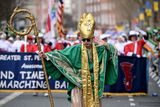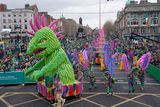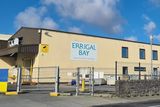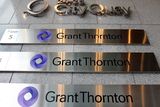‘Dublin is alive and well and open for business,’ says Saint Patrick’s festival chief
The capital’s reputation overseas took a battering last year, but festival CEO Richard Tierney is confident the work they’ve put in will cast the city in its best light



The chief executive of St Patrick’s Festival has spent many long hard months preparing to welcome a predicted 550,000 visitors to the streets of Dublin this weekend for the annual national tourism bonanza.
Speaking with the Sunday Independent ahead of the event, Richard Tierney, who was appointed CEO in the summer of 2022, said foreign tourists are a substantial boost to the country’s economy.
Referring to calls for the lifting of the passenger cap at Dublin Airport, Tierney said he would welcome any move that helped increase the number of overseas tourists travelling to Ireland.
“Our stance is that we would welcome anything that is going to increase the footfall of inbound visitors. From an economic perspective, they really do have a bit to spend.”
St Patrick's Festival CEO, Richard Tierney
The number predicted this year is up from 530,000 last year, with a high proportion of those coming from overseas.
“We are the kick-off to the tourist season. That is our privileged position. We are the first major event of the year.”
Tierney, who has a background in cutting large commercial deals, including selling the naming rights for the Grand Canal Theatre when it became the Bord Gáis Energy Theatre, was given a brief to help make the St Patrick’s event less reliant on public funding.
“Roughly, we receive between 65pc and 70pc funding from the State,” said Tierney. “We have to go find the rest.
Read more
“What we are trying to do is chip away at that number and become more self-sufficient year-on-year through a combination of commercial operations and sponsorship – those key proven mechanics that work.”
Tierney has an ambition to get the festival to only being 50pc funded by the public purse.
We need to maintain the grassroots of the festival in terms of community pageants and participants
“What I am delighted with this year is we have given ourselves a consistent commercial base. We now know what works, and we just need to build on that.
“Will we ever get the reliance to 50/50? I have no idea. But certainly, that is the journey we are on.”
Part of the journey will be attracting key sponsors.
Tierney says Kia has returned this year as its lead partner, with other brands, including yoghurt brand Nomadic and Tayto attracted by the chance to associate themselves with the famous festival.
“It is a balance of being over-commercial and doing enough to make sure that we grow in terms of stability for the festival,” he says.
“Kia would be a perfect example of a multi-annual partner, and we are very much in the market to add to that in 2025. At the same time, we need to maintain the grassroots of the festival in terms of community pageants and participants.”
The financial gains we make in one area could be nullified by increases in another. That’s not a whinge. That’s life
Given the inflationary environment across materials and labour, the cost of running the festival continues to rise.
“Not only inflation, the cost of services, security, steel – everything is going in one direction,” says Tierney. “The gains we make in one area could be nullified by increases in another.
“That is not a whinge. That is life.”
With the large number of international tourists making their way to Dublin for the festival, the city’s hotels are in high demand.
However, capacity has been stretched over the past few years, with refugees fleeing conflicts around the world taking up much space.
Have issues around capacity been a problem for the festival this year?
“It doesn’t really affect us as event organisers as it has been here for a number of years,” said Tierney. “It affects the consumer experience and the inbound experience.
“It is not ideal. The marching bands have to stay in a wider arc outside the city because the accommodation isn’t there for them. They are resourceful, and they found alternatives.”
Performers take part in the St Patrick's Day Parade in Dublin last year. Photo: Brian Lawless/PA
Hotel accommodation is not Dublin’s only issue for many potential tourists.
The capital’s reputation took a hit last year after it attracted global headlines in the wake of the riots that gripped the city centre.
Not only that, a high-profile assault on an American tourist in the north inner city also attracted attention in the US – one of Ireland’s leading tourist markets – and piled pressure on Justice Minister Helen McEntee to enhance the presence of gardaí on the streets.
“We are here to say Dublin is alive and well and open for business,” says Tierney. “We are going to put our best foot forward on March 17.
“I am privileged to have the steering wheel of the national day,” he added. “Even though it takes a year to organise, we do this for the three days of the festival. We have to make sure it is as positive an experience for as many people as we can. That is what we aim for and try to do.”
It is either going to be mega or mega-mega. If it is a sunny day, it will be mega-mega
Tierney has big ambitions for this year’s festival. He hopes nothing will dampen the spectacle.
“It is going to be our biggest yet, with over 4,000 participants. I am really happy with it. It has some really cool new innovations.
“Weather can always make it,” he added. “It is either going to be mega or mega-mega. If it is a sunny day, it will be mega-mega.”
Read more
Join the Irish Independent WhatsApp channel
Stay up to date with all the latest news













